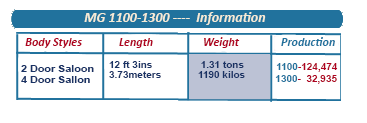
Released in conjunction with the new front wheel drive Morris 1100, the MG 1100 a tuned-up and better-trimmed derivative of that car and was always built alongside it at Cowley.
A part from having the archetypal MG front grille, and a higher standard of trim and furnishing inside the cabin, the MG looked almost exactly like the Morris (and, of course, the Austin, Vanden Plas, Riley and Wolseley clones that would follow.
part from having the archetypal MG front grille, and a higher standard of trim and furnishing inside the cabin, the MG looked almost exactly like the Morris (and, of course, the Austin, Vanden Plas, Riley and Wolseley clones that would follow.
All these family members shared the same Farina-styled monocoque hull — in two-door saloon or four-door saloon forms but with no other versions — and all used the revolutionary new all-independent "riding on liquid" Hydrolastic suspension
The MG 1100 might well have been looked upon as yet another recycled BMC product, although to many it did have its share of saving graces, with BMC succeeding in retaining some of the traditional MG spirit and driving enhancements.
T hese enhancements included first class handling, sharp steering, and willing engines, even in the earliest 1098cc (67 cu in) models, meant that these small MG saloons could be driven flat-out almost the time.
hese enhancements included first class handling, sharp steering, and willing engines, even in the earliest 1098cc (67 cu in) models, meant that these small MG saloons could be driven flat-out almost the time.
Two-door models were "export only" until 1968, when there was an about-face in product planning.
From then onwards two-door MG 1100s became a common sight on UK roads.
Early developments included fitting a proper tree-wood fascia from early 1963, and reclining front seats became optional early in 1966.
![]()
1100 cc engined Mk Is were sluggish to drive, and according to MG dealers even more sluggish to sell, meaning that this version had it plug pulled in 1968.
From October 1967, a Mk II version appeared taking over from the Mk I.

 he Mk II 1100 came complete with chopped-back tail fins, and even optional AP automatic transmission from 1967 to 1969.
he Mk II 1100 came complete with chopped-back tail fins, and even optional AP automatic transmission from 1967 to 1969. 1100 cc engined Mk Is were sluggish to drive, and according to MG dealers even more sluggish to sell, meaning that this version had it plug pulled in 1968. From late 1968, the 1300 was advanced to become the MG 1300 Mk II, fitted with a twin-SU 70bhp engine, closer-ratio gears, radial ply tires and a brand-new instrument display featuring circular instruments (and a rev counter, at last!).
This specification was not unique, shared by the Austin/Morris 1300GTs for a time.
![]()
The 1300 engined version, produced from 1968, were the best, with a 1275 (78 cu in) twin-carburettor version of BMC’s popular A-Series engine under the bonnet, was capable of reaching a top speed of 100 mph (162 k/ph).
N aturally, and as expected, the 1300 Mk II was not only the best but also the best-liked, of all this family of front-wheel drive ADO 16 types.
aturally, and as expected, the 1300 Mk II was not only the best but also the best-liked, of all this family of front-wheel drive ADO 16 types.
Combining comfort, performance, road holding and a certain” Olde Worlde”
charm, the intrinsical characteristic of MG saloons for decades.
Characteristics that would soon be forgotten with the final passing of the MG1100- 1300 series in 1973.






